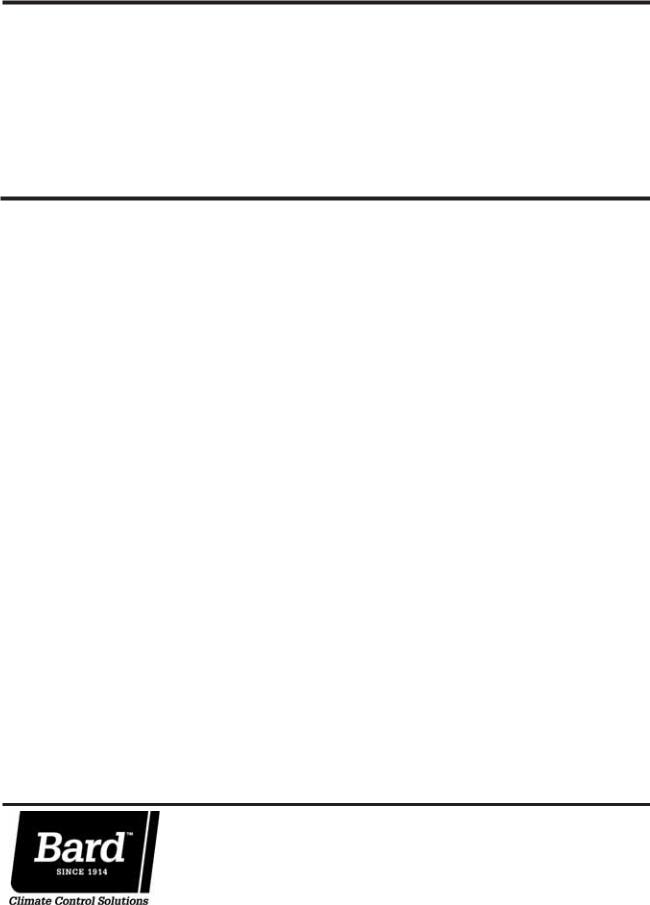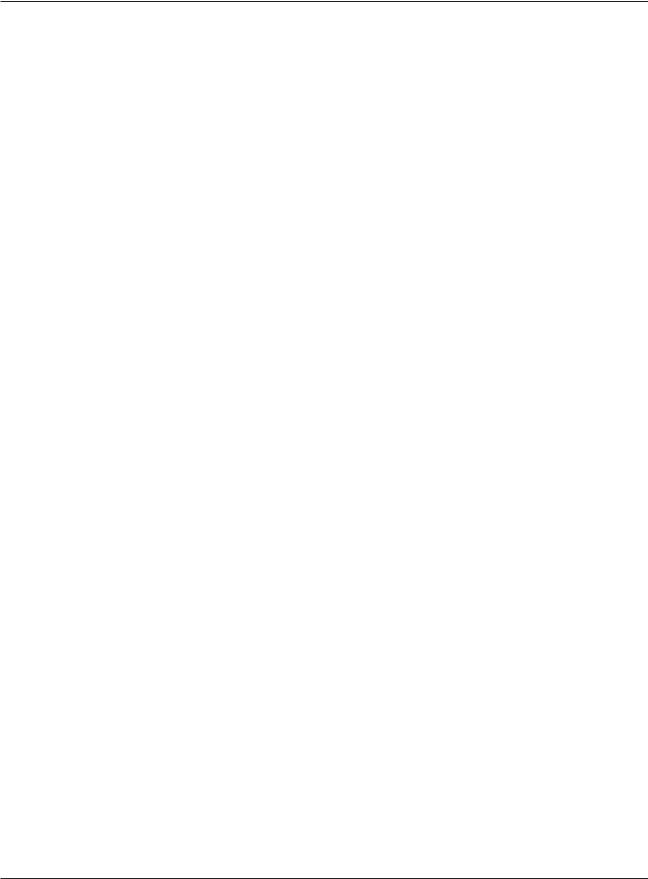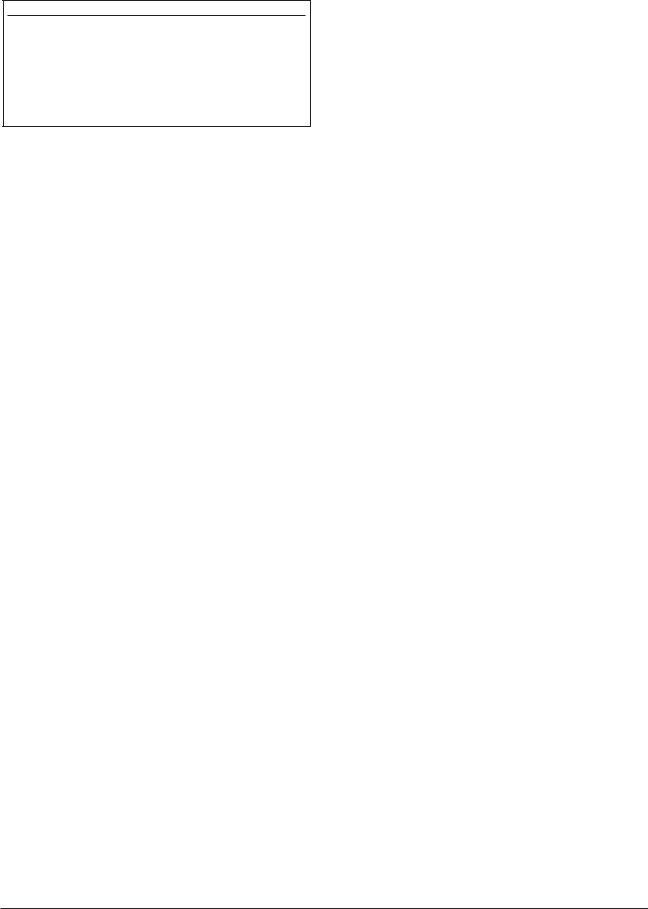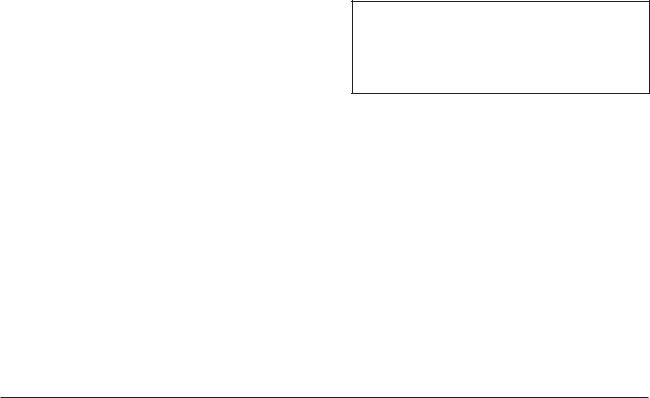Bard DC3002, Dc3003 User Manual

INSTALLATION INSTRUCTIONS & REPLACEMENT PARTS LIST
DC3002 and DC3003 SOLID STATE LEAD/LAG CONTROLLER
with DC FAN CONTROL
Bard Manufacturing Company, Inc. |
Manual No.: |
2100-484E |
|
Bryan, Ohio 43506 |
Supersedes: |
2100-484D |
|
Since 1914...Moving ahead, just as planned. |
File: |
Vol. III Tab 19 |
|
Date: |
08-29-11 |
||
|
|
Manual |
2100-484E |
|
|
Page |
1 of 22 |
|

CONTENTS
Getting Other Information and Publications |
3 |
DC3000 General Information |
|
Shipping Damage .................................................. |
4 |
General .................................................................. |
4 |
Theory of Operation ............................................... |
4 |
Controller Certifications ......................................... |
4 |
Specifications/Features for Basic Controller |
|
DC3000 Basic Controller ....................................... |
5 |
Mounting the Controller |
|
Installation Instructions .......................................... |
5 |
Temperature Sensors |
|
Remote Indoor Sensor ........................................... |
5 |
Remote Outdoor Sensor ........................................ |
5 |
Temperature Sensor Logic |
|
Using Multiple Sensors .......................................... |
5 |
Controller Input/Output Specifications |
|
Main Controller Board ............................................ |
6 |
Internal Alarm Board .............................................. |
6 |
Low Voltage Field Wiring |
|
Circuitry in the DC3000 .......................................... |
7 |
Controller Grounding |
|
Earth ground .......................................................... |
7 |
Controller Power-Up |
|
Time Delay on Power-Up ....................................... |
7 |
Fire Suppression Circuit |
|
Disabling the DC3000 ............................................ |
7 |
Staging Delay Periods |
|
Stages 1 - 4 ............................................................ |
7 |
Blower Operation |
|
Various Blower Options ......................................... |
7 |
Advance (Swap) Lead/Lag Unit Feature |
|
Manual Switching of Units ..................................... |
7 |
Accelerate Timer Feature |
|
Testing the Timer Function ..................................... |
7 |
Humidity Control Option |
|
Adding Optional Humidity Control .......................... |
8 |
Sequence of Operation - Cooling (Air Conditioners) |
|
No Economizer ...................................................... |
8 |
With Economizers .................................................. |
8 |
Sequence of Operation - Heating (Air Conditioners) |
|
With Electric Heat .................................................. |
9 |
Security (Locking) Feature |
|
|
|
Locking and Unlocking the DC3000 ...................... |
|
9 |
|
Generator Run Feature |
|
|
|
Standby Generator Disable Operation ................... |
|
9 |
|
Backup DC Power Connection |
|
|
|
Input Connections Available .................................. |
|
9 |
|
DC Fan Control |
|
|
|
Free Cooling & Emergency Ventilation ................ |
|
10 |
|
Shelter Purge Control .......................................... |
|
10 |
|
Controller Wiring |
|
|
|
Refer to Connection Diagram ...................... |
10 & 11 |
||
Alarm Wiring |
|
|
|
Wiring Alarm Relays ............................................ |
|
16 |
|
2nd Stage Cooling Alarm |
|
|
|
Alarm Output is Available ..................................... |
|
16 |
|
Refrigerant Pressure Alarms |
|
|
|
Connecting the Alarm Circuit ............................... |
|
16 |
|
Emergency Ventilation Sequence |
|
|
|
Using Economizers |
|
|
|
Two Operating Sequences .................................. |
|
16 |
|
Programming Instructions ................................... |
|
19 |
|
Figures |
|
|
|
Figure 1 DC3002 Controller Connections for 2 Air |
|
||
|
Conditioners with Economizer ................... |
|
11 |
Figure 2 DC3002 Controller Connections for 2 Air |
|
||
|
Conditioners with No Economizer .............. |
|
12 |
Figure 3 DC3003 Controller Connections for 3 Air |
|
||
|
Conditioners with 3 Economizers .............. |
|
13 |
Figure 4 DC3003 Controller Connections for 3 Air |
|
||
|
Conditioners with Economizers |
|
|
|
(No Economizer A/C #3)......................... |
|
14 |
Figure 5 DC3003 Controller Connections for 3 Air |
|
||
|
Conditioners with No Economizers ............ |
|
15 |
Figure 6 Alarm Board Connections for Normally Closed |
|||
|
“NC” Open-On-Alarm Strategy ................... |
|
17 |
Figure 7 Alarm Board Connections for Normally |
|
||
|
Open “NO” Close-On-Alarm Strategy ..... |
18 |
|
(Label) |
DC3000 Series ....................................... |
|
20 |
Figure 8 Parts List Description ............................. |
|
21 |
|
Tables |
|
|
|
Table 1 Controller Connection Diagrams ............ |
|
10 |
|
Table 2 |
Parts List ................................................ |
|
22 |
Manual |
2100-484E |
Page |
2 of 22 |

Getting Other Information and Publications
These publications can help you install the air conditioner or heat pump. You can usually find these at your local library or purchase them directly from the publisher. Be sure to consult current edition of each standard.
Standard for the Installation .............. |
ANSI/NFPA 90A |
of Air Conditioning and |
|
Ventilating Systems |
|
Standard for Warm Air Heating ........ |
ANSI/NFPA 90B |
and Air Conditioning Systems |
|
FOR MORE INFORMATION, CONTACT THESE PUBLISHERS:
ACCA |
Air Conditioning Contractors of America |
|
1712 New Hampshire Avenue, NW |
|
Washington, DC 20009 |
|
Telephone: (202) 483-9370 |
|
Fax: (202) 234-4721 |
ANSI |
American National Standards Institute |
|
11 West Street, 13th Floor |
|
New York, NY 10036 |
|
Telephone: (212) 642-4900 |
|
Fax: (212) 302-1286 |
ASHRAE |
American Society of Heating, Refrigerating, |
|
and Air Conditioning Engineers, Inc. |
|
1791 Tullie Circle, N.E. |
|
Atlanta, GA 30329-2305 |
|
Telephone: (404) 636-8400 |
|
Fax: (404) 321-5478 |
BARD |
Bard Manufacturing Company, Inc. |
|
1914 Randolph Drive |
|
Bryan, OH 43506 |
|
Telephone: (419) 636-1194 |
|
Fax: (419) 636-2640 |
Manual |
2100-484E |
Page |
3 of 22 |

** IMPORTANT **
The equipment covered in this manual is to be installed by trained, experienced service and installation technicians. Please read entire manual before proceeding.
SHIPPING DAMAGE
Upon receipt of equipment, the carton should be checked for external signs of shipping damage. If damage is found, the receiving party must contact the last carrier immediately, preferably in writing, requesting inspection by the carrier’s agent.
GENERAL
NOTE: DC3000 is used throughout this Manual as a general reference to the controller system. There are two controller models, DC3002 for 2 HVAC units and DC3003 for 3 HVAC units, and these model numbers are referenced when specific features or characteristics apply only to either the DC3002 or the DC3003. Occasional reference is made to alarm board AB3002 or AB3003. AB3002 is the internal alarm board for the DC3002 controller, and AB3003 is the internal alarm board for the DC3003 controller.
These instructions explain the operation, installation and troubleshooting of the DC3000 controller.
All internal wiring is complete. Only attach low voltage field wiring to designated terminal strips.
The DC3000 is for use with units with or without economizers, and has a dehumidification control feature if an optional humidity controller is connected.
Each unit should be sized to handle the total load of the structure if 100% redundancy is required.
It is recommended that a five (5) minute compressor time delay relay be installed in each unit.
The DC3000 controllers are suitable for both 50 and 60 HZ operation, and are fully configurable such that they can be used in virtually any installation. See Controller Programmable Features and Default Settings.
THEORY OF OPERATION
The DC3002 controller is used to control two wall mount air conditioners from one control system. It provides total redundancy for the structure and equal wear on both units. It can be used with units with or without economizers and it is recommended that both units be equipped alike.
The DC3003 controller is designed to control 3 air conditioners, and can be used for 2 if it is anticipated the third unit may be installed later.
NOTE: If this is done, see Note 1 on Alarm Board Connections (Figure 6 or 7) to prevent nuisance Power Loss Alarm indication for absent HVAC #3
When DC3003 is used for controlling three HVAC units, only units 1 or 2 operate in lead/lag sequence. HVAC #3 is always last to operate and functions only in the number 3 position. All three units are available to operate on-demand as required.
Alarm capability is standard on both models.
CONTROLLER CERTIFICATIONS
The DC3000 main controller board, optional alarm boards, and remote sensors have undergone extensive testing for immunity and emissions. This system is FCC-compliant, in accordance with CE requirements, and meets the following standards:
EN50082-2 Standard for Immunity
EN55011 Standard for Emissions
Manual |
2100-484E |
Page |
4 of 22 |

SPECIFICATIONS/FEATURES FOR BASIC CONTROLLER
DC3000 Basic Controller
•Input power: 18 to 32VAC, 60/50Hz, power is supplied from A/C #1 and/or A/C #2
•Isolation circuitry: no line or low voltage phasing required
•Backup power: connection for -24VDC or -48VDC (-20 to -56V) maintains microprocessor operation, front panel indication, and alarm relay operation during commercial power outages.
•Digital display: 4-character LCD •Temperature display: F or C
•HVAC outputs: Form A (NO) relays (1A @ 24VAC) •Cooling control stages: 2 for each A/C unit •Heating Control stages: 1 for each A/C unit •Dehumidification circuit: requires optional humidity controller as input signal.
•Operating temperature range: 0 to 120F (-18 to 49C) •Storage temperature range: -20 to 140F (-29 to 60C) •Temperature accuracy: +/- 1F from 60-85F (16-30C)
+/- 1% outside 60-85F •Lead/lag changeover time: 0 to 30 days •Timing accuracy: +/- 1%
•Inter-stage time delay: 10 seconds between stages •Inter-stage differential: 2F (1C) for all modes •On-Off differential: 2F (1C) is standard, 4F (3C) when “excessive cycling” mode is enabled.
•Cooling set point range: 65 to 90F (18 to 32C) •Comfort setting-Cooling 72F (22C), Heating 68F(20C), for 1 hour.
•Dead band (difference between cooling and heating set points): 2F to 20F (1C to 10C)
•Fire/smoke interface: standard NC circuit jumper, remove for connection to building system control, shuts down both A/C units immediately.
•Memory: EEPROM for set point and changeable parameters (maintains settings on power loss). •Temperature sensors: 1 local is standard, will accept up to 2 optional 25-foot remote sensors, Bard part number 8612-023. One can be used for remote indoor sensor and one is dedicated for outdoor sensor for DC Fan free cooling operation, if desired.
•Controller Enclosure: 20-gauge pre-painted steel, 9.25"W x 13.50"H x 3.00"D, hinged cover, thirteen (13) .875" diameter electrical knockouts.
•LEDs for basic controller: Lead unit, Cooling stages 1 through 4, Heating Stages 1 through 4, Dehumidification operation. DC3003 has cooling stage and alarm LED’s displayed internally for HVAC #3.
•Six (6) Push-button controls: On/Off switch-Change lead unit-Increase and Decrease set points-Program/Save- Comfort.
MOUNTING THE CONTROLLER
Included in the controller carton is the controller and installation instructions.
The controller should be installed on a vertical wall approximately four (4) feet above the floor - away from drafts and outside doors or windows. Four (4) mounting holes are provided for mounting to the wall, and 7/8" holes for conduit connections are provided in both the base, sides and top of the controller.
TEMPERATURE SENSORS
The standard (local) temperature sensor has 12" leads and comes installed from the factory.
The controller is designed to accept 1 additional remote indoor sensor, and connects to “Rem 1”. The Bard part number for the optional sensor with 25-foot leads is 8612-023. This remote indoor sensor can be installed as required in the structure to address hot spots, barriers to airflow, etc. It can also be used as the local sensor
Outdoor sensor, same 8612-023 with 25-foot leads, is required for non-economizer installations when DC fan is to be used for free cooling. This sensor connects to the “Out” terminals.
It is recommended that the sensor lead wires be installed in conduit for protective purposes.
The highest reading of any connected indoor sensor will be used for high temperature alarm and the lowest reading sensor will be used for low temperature alarm.
NOTE: All sensors are polarity sensitive. The copper lead must connect to terminal CU, and the silver lead to AG.
Sensors are solid state, not RTD.
Use only sensors supplied by Bard.
TEMPERATURE SENSOR LOGIC
The standard local (Loc) sensor monitors the temperature at the controller location. If this is the only sensor connected, it will control the temperature read-out, the space (building) temperature, and also be used for Low and High Temperature alarm functions.
If one REMOTE sensor is installed and connected (Rem 1), the temperature read-out will display and the building will be controlled to an average of connected sensors. If there is more than 10F difference from the highest to the lowest connected sensor, the actual control will be governed by the hottest sensor for cooling and the coldest sensor for heating.
If two indoor temperature sensors are used, the average of the two sensors becomes the controller cooling and testing set point.
Manual |
2100-484E |
Page |
5 of 22 |

CONTROLLER INPUT/OUTPUT SPECIFICATIONS
DC3002/3003 CONTROLLER CONNECTIONS
Located on Main Controller Board
Unit #1 |
|
C – 24VAC common |
|
|
|
|
R – 24VAC hot |
|
|
|
|
G – fan (Form A, NO) |
|
|
|
|
Y1 – 1st-stage cool (Form A, NO) |
||
|
|
Y2 – 2nd-stage cool (Form A, NO) |
||
|
|
W – heat (Form A, NO) |
|
|
Unit #2 |
|
C – 24VAC common |
|
|
|
|
R – 24VAC hot |
|
|
|
|
G – fan (Form A, NO) |
|
|
|
|
Y1 – 1st-stage cool (Form A, NO) |
||
|
|
Y2 – 2nd-stage cool (Form A, NO) |
||
|
|
W – heat (Form A, NO) |
|
|
Unit #3 |
|
C – 24VAC common |
|
|
(DC3003 only |
R – 24VAC hot |
|
||
and located on |
G – fan (Form A, NO) |
|
||
InternalAlarm |
Y1 – 1st-stage cool (Form A, NO) |
|||
Board) |
|
Y2 – 2nd-stage cool (Form A, NO) |
||
|
|
W – heat (Form A, NO) |
|
|
F1-F2 |
Fire/smoke interface |
|
||
|
Shipped with jumper installed (a) |
|
||
48Vdc |
Back-up power input |
|
||
|
-24Vdc or –48Vdc |
|
||
|
-20V to –56V range |
|
||
Local |
Main sensor, 12-inch leads |
|
||
NOTE: |
||||
|
CU – copper, AG – silver |
|||
|
|
|||
|
Polarity sensitive |
Sensors are |
||
Rem 1 |
Optional remote indoor sensor |
solid state, |
||
|
CU – copper, AG – silver |
|||
|
not RTD. |
|||
|
Polarity sensitive |
|||
|
|
|||
Out |
Optional outdoor sensor (b) |
Use Bard |
||
|
CU – copper, AG – silver |
sensors only. |
||
|
Polarity sensitive |
|
||
|
|
|||
Gen |
Generator interface G1-G2 |
|
||
|
Shipped with jumper installed (a) |
|
||
H1-H2 |
Humidity controller input |
|
||
|
Requires optional controller |
|
||
|
Field installed |
|
||
(a)These connections require either jumper or Normally Closed (NC) relay contact at the Fire/Smoke and Generator interface for Controller to function.
(b)Required connection if field installed DC Fan is to be used for free cooling and no economizers are installed in HVAC units.
Note: All alarm relays are dry contacts rated 1A @ 24VAC, 120VAC or 150VDC.
DC3002/3003 CONTROLLER CONNECTIONS
Located on Internal Alarm Board AB3002
DC3002 Inputs |
|
Lockout 1 |
2,3 – input from HVAC #1 |
Lockout 2 |
2, 3 – input from HVAC #2 |
Y Unit 1 |
signals when comp. #1 is active |
Y Unit 2 |
signals when comp. #2 is active |
DC3002 Alarm Outputs |
|
Smoke/Fire |
Form C (SPDT) |
Lockout 1 |
Form C (SPDT) |
|
Refrigerant alarm HVAC #1 |
Lockout 2 |
Form C (SPDT) |
|
Refrigerant alarm HVAC #2 |
Power Loss 1 |
Form C (SPDT) |
|
Power loss HVAC #1 |
Power Loss 2 |
Form C (SPDT) |
|
Power loss HVAC #2 |
Low Temp |
Form C (SPDT) |
|
Low temperature alarm |
High Temp 1 |
Form C (SPDT) |
|
High temperature alarm #1 |
High Temp 2 |
Form C (SPDT) |
|
High temperature alarm #2 |
Controller |
Form C (SPDT) |
|
Controller failure alarm |
DC3002 Control Outputs |
|
Econ 1 |
E, F - Form A (NO) |
|
See note (c ) |
Econ 2 |
E, F - Form A (NO) |
|
See note (c ) |
DC Fan |
Form C (SPDT) |
|
Pilot relay for DC Fan control |
2nd Stage |
Form C (SPDT) |
|
2nd-stage cooling alarm |
(c ) Make these connections to terminals E & F in HVAC 1 and 2 respectively if desired to have economizers open for emergency ventilation at High Temp Alarm #2 setpoint condition.
DC3003 Inputs
Everything from DC3002 plus:
Lockout 3 |
2,3 – input from HVAC #3 |
DC3003 Alarm Outputs (on AB3003 Internal Alarm Board) |
|
Everything from DC3002 plus: |
|
Lockout 3 |
Form C (SPDT) |
|
Refrigerant alarm HVAC # 3 |
Power Loss 3 |
Form C (SPDT) |
|
Power loss HVAC #3 |
DC3003 Control Outputs |
|
Econ 3 |
E, F - Form A (NO) |
|
See note (c ) |
Alarm relays can be wired for NO (close on alarm) or NC (open on alarm) strategy. Alarm relays can be used individually if there are enough available building alarm points, or can be arranged into smaller groups or even a single group so that all alarm capabilities can be utilized. When multiple alarms are grouped together and issued as a single alarm there will be no off-site indication of which specific problem may have occurred, only that one of the alarms in the group has been triggered. The individual alarm problem will be displayed on the LED display on face of the controller.
Manual |
2100-484E |
Page |
6 of 22 |

LOW VOLTAGE FIELD WIRING
The DC3000 is powered from the air conditioners that it is controlling, 24VAC (18-32V) low voltage only.
Circuitry in the DC3000 isolates the power supplies of all connected air conditioners so that no back feeds or phasing problems can occur. Additionally, if any air conditioner loses power, the DC3000 and the other air conditioner are unaffected and will continue to operate normally.
Connect the low voltage field wiring from each unit per the low voltage field wiring diagrams in Section on “Controller Wiring”.
CONTROLLER GROUNDING
A reliable earth ground must be connected in addition to any grounding from conduit.
CONTROLLER POWER-UP
Whenever power is first applied to the controller, there is a twenty (20) second time-delay prior to any function (other than display) becoming active. This time-delay is in effect if the controller On/Off button is used when 24VAC from air conditioners is present, and also if controller is in “ON” position and 24VAC from all connected air conditioners is removed and then restored.
FIRE SUPPRESSION CIRCUIT
To disable the DC3000 and shut down both air conditioners, terminals F1 and F2 may be used. The F1 and F2 terminals must be jumpered together for normal operation. A normally closed (nc) set of dry contacts may be connected across the terminals and the factory jumper removed for use with a field-installed fire suppression system. The contacts must open if a fire is detected. See appropriate connection diagram - Figures 1, 2 or 3 for this connection. Contacts should be rated for pilot duty operation at 2 amp 24VAC minimum. Shielded wire (22-gauge minimum) must be used, and the shield must be grounded to the controller enclosure.
IMPORTANT NOTE: Some Bard models employ an electronic blower control that has a 60-second blower off-delay. In order to have immediate shutdown of the blower motor, in addition to disabling the run function of the air conditioners will require a simple wiring modification at the blower control located in the electrical control panel of the air conditioners being controlled by the lead/lag controller. To eliminate the 60-second blower off-delay, disconnect and isolate the wire that is factory-connected to the “R” terminal on the electronic blower control, and then connect a jumper from the “G” terminal on the blower control to the “R” terminal on the blower control. The electronic blower control will now function as an on-off relay with no offdelay, and the blower motor will stop running immediately when the F1-F2 fire suppression circuit is activated (opened).
STAGING DELAY PERIODS
The following delays are built in for both cooling and heating:
Stage 1 – 0 seconds for blower (if not already on as continuous)
10 seconds for cooling or heating output
Stage 2 – 10 seconds after Stage 1 for blower
10 additional seconds for cooling or heating output
Stage 3 – 10 seconds after Stage 2
Stage 4 – 10 seconds after Stage 3
Note: For cooling Stages 1 and 2, the stage LED will blink for 10 seconds while the cooling output is delayed after that stage is called for. There is also a delay after the stage is satisfied, and after the LED stops blinking, the stage will turn off. There is a minimum 10-second delay between stages 2 & 3, and 3 & 4, but no delayed output when stage is turned on or off, and LED for those stages will not blink.
BLOWER OPERATION
The controller can be configured to have main HVAC blowers cycle on and off on demand; have all blowers run continuously (for DC3003, the blower is not “On” continuously for HVAC #3, but runs on demand only condition); or have the lead unit blower run continuously with the lag unit blower cycling on demand. Lead unit blower operating continuously is the default setting. There is also an option to have all blowers cycle on if one remote sensor is connected, and a temperature difference of more than 5F between any two sensors is observed. This helps to redistribute the heat load within the structure and should reduce compressor operating time.
When any of the stages are satisfied, the stage LED will blink for ten (10) seconds before the stage is actually turned off.
ADVANCE (SWAP) LEAD/LAG UNIT FEATURE
Pressing the Advance button for one (1) second will cause the lead and lag units to change positions. This may be useful during service and maintenance procedures.
Note: DC3003 always operates HVAC #3 in last position: only HVAC #1 and #2 operate in lead/lag sequence.
ACCELERATE TIMER FEATURE
Pressing the UP arrow button for five (5) seconds will activate an accelerate (speed-up) mode, causing the normal changeover time increments of days to be reduced to seconds. Example: 7 days becomes 7 seconds. When “ACC” displays, release button. Whichever LED is on, indicating lead unit will blink over for each second until the controller switches. This is a check for the timer functionality.
Manual |
2100-484E |
Page |
7 of 22 |
